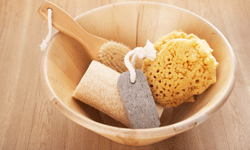The largest organ in the body is also the most dynamic: Our skin is never exactly the same from day to day. The skin's surface -- all 2 square yards (1.7 square meters) of it -- is constantly sloughing off dead cells so new, living cells can move up from the lower layer and make us look younger, smoother and more glowing [source: Your Total Health].
This skin cycle is ideal in infancy, when the outer layer of skin is replaced about every few days, accounting at least in part for that bright, baby-soft skin (lack of sun exposure helps, too) [source: CGPS]. Skin-cell turnover slows as we age, to about weekly as children and every three weeks in our 20s [source: Paula's Choice]. After that, it's closer to once a month [source: DERMAdoctor]. The result of slower skin-cell replacement is duller, less even-looking skin, blemishes and more fine lines.
Advertisement
That's where exfoliation comes in. To exfoliate simply means to shed off the outer layer of dead skin cells so fresher ones can take their place. This makes skin look healthier and also makes it better at absorbing treatments like moisturizers.
There are lots of different ways to accomplish this. The method most people know about is the "scrub" -- the rough, creamy substance you massage into your skin and then rinse away. Scrubs can incorporate any number of substances to achieve the rough consistency that sloughs off cells, from ground-up fruit pits to sugar to oatmeal to plastic "microbeads." These are called physical exfoliants. You can also use chemical exfoliants, which take a different approach to removing skin cells.
In this article, we'll take a look at five of the best exfoliants out there for face and body. We'll find out what makes these exfoliants safe and effective, which skin types they're best suited to, and why some popular exfoliants are less than ideal.
We'll begin with what's probably the simplest method of physical exfoliation: the time-tested loofah sponge.
